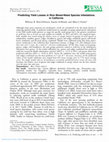Papers by Whitney Brim-DeForest
California agriculture, Jun 3, 2024
Survey shows farmers need more information on new products and technologies, soil health manageme... more Survey shows farmers need more information on new products and technologies, soil health management, and water conservation and storage.

Frontiers in agronomy, Jan 30, 2024
Historically, herbicides were used for Echinochloa spp control in California rice production whic... more Historically, herbicides were used for Echinochloa spp control in California rice production which led to the selection of herbicide-resistant biotypes. Field surveys were conducted across the seven major rice-growing counties in 2020 and Echinochloa spp samples including barnyardgrass (Echinochloa crus-galli (L.) P.Beauv.), junglerice (Echinochloa colona (L.) Link), late watergrass (Echinochloa oryzicola (Vasinger) Vasinger) and coast cockspur (Echinochloa walteri (Pursh) Heller) were collected. Greenhouse experiments were carried out to determine their suspected resistance to common preemergence and postemergence rice herbicides used in California in Fall and Winter of 2021. A total of 62 and 63 samples were characterized for suspected resistance to four preemergence granular and three postemergence foliar-applied herbicides, respectively. When granular herbicides were evaluated, samples suspected of resistance in Winter were a subset of samples that were suspected of resistance in Fall. Results indicate >90% of Echinochloa spp samples were resistant to thiobencarb, benzobicyclon + halosulfuron and penoxsulam when combined across species and counties. Cross-resistance between benzobicyclon + halosulfuron and penoxsulam was observed in >90% of the samples when combined across species and counties. Suspected clomazone resistance was observed in <75% of the samples when combined across species and counties. Suspected resistance to cyhalofop and propanil was observed in <50% of the samples when averaged across both runs. Multiple-resistance to foliar herbicides ranged from 48-60% of the samples across species and experimental runs. These results indicate the necessity for rotating herbicides during alternate cropping seasons and emphasizing integrating non-chemical strategies for Echinochloa spp control in California rice production.

Journal of Experimental Zoology Part A: Ecological Genetics and Physiology, 2008
The ability to change direction is essential to any animal that moves around in a complex, 3D env... more The ability to change direction is essential to any animal that moves around in a complex, 3D environment. In this study we present the first 3D description of body positions during gliding turns in a mammalian gliding specialist, the southern flying squirrel, Glaucomys volans. In addition, we used these kinematic data to estimate the aerodynamic forces generated by the animals and rotational velocities and accelerations of the body while turning. These results were compared with similar measurements of flying squirrels during straight glides. The two individuals used in this study differed significantly in limb position asymmetries between the two sides of their bodies and also were significantly different in measures of turning performance. The individual with better performance used limb positions consistent with a primarily lift-based turning mechanism (banked turn), whereas the individual with poorer performance used limb positions consistent with a primarily drag-based turning mechanism (crabbed turn). Both individuals employed limb movements continuously through the gliding turn, but these movements did not have any consistent relationships with body rotations or lateral acceleration. As compared with straight glides, squirrels used significantly higher angles of attack and had lower lift-to-drag ratios, but did not differ in glide angle. Contrary to the typical view of maneuvering during gliding as a simple, static form of locomotion, the results presented here indicate that mammalian gliding is a complex behavior comprising the interplay of many components of limb position and wing shape that affect the balance of forces that control the turn.

Frontiers in Agronomy
Flooded rice soils are unique in terms of maintaining soil fertility and long-term productivity, ... more Flooded rice soils are unique in terms of maintaining soil fertility and long-term productivity, allowing continuous rice systems to contribute greatly to global food supply. Yet increasing herbicide resistant weed pressure, water scarcity, and other sustainability challenges suggest a need to explore options for cropping system diversification. However, little research has evaluated the current obstacles limiting diversification of rice systems in different contexts. During summer and fall of 2020 we interviewed 42 rice growers to (i) assess the perceived benefits and challenges of crop rotation in the context of California rice systems and (ii) identify the factors influencing decision-making and barriers to adoption. Rice-based cropping systems ranged from high to low diversity across three different categories of growers (conventional rotations > organic > continuous rice). Key factors influencing the feasibility of rotations were soil limitations, production costs and pro...
Genotype data from 99 genetic markers described in the file GeneticMarkers.csv for 96 rice sample... more Genotype data from 99 genetic markers described in the file GeneticMarkers.csv for 96 rice samples described in the file SampleDescription.csv. Data contains codominant marker data with two columns for each locus and one line per sample. Alleles are numbered 1 through n for each marker. Missing data is coded as 0
Distribution and allele variation of 98 microsatellite markers and 1 Rc gene-specific marker amon... more Distribution and allele variation of 98 microsatellite markers and 1 Rc gene-specific marker among 96 weedy, cultivated and wild rices. Microsatellite marker primer sequences are most accessible from the Gramene database (http://archive.gramene.org/markers/microsat/) but were published in: International Rice Genome Sequencing Project (2005) The map-based sequence of the rice genome. Nature 436:793-800. The Rc marker is published in Subudhi et al. 2012: Subudhi, P.K, Parco, A., Singh, P.K., De Leon, T., Karan, R., Biradar, H., Cohn, M.A., Brar, D.S., & Sasaki, T. (2012) Genetic architecture of seed dormancy in US weedy rice in different genetic backgrounds. Crop Science 52: 2564-2575
List of rice genotypes used in genetic study, genotype source, grain attributes, and presence or ... more List of rice genotypes used in genetic study, genotype source, grain attributes, and presence or absence of 14-basepair deletion in Rc gene

Weed Science, 2022
Weedy rice (Oryza sativa f. spontanea Roshev.) has recently become a significant botanical pest i... more Weedy rice (Oryza sativa f. spontanea Roshev.) has recently become a significant botanical pest in California rice (Oryza sativa L.) production systems. The conspecificity of this pest with cultivated rice negates the use of selective herbicides, rendering the development of nonchemical methods a necessary component of creating management strategies for this weed. Experiments were conducted to determine the emergence and early growth responses of O. sativa spontanea to flooding soil and burial conditions. Treatment combinations of four flooding depths (0, 5, 10, and 15 cm) and four burial depths (1.3, 2.5, 5, and 10 cm) were applied to test the emergence of five O. sativa spontanea accessions as well as ‘M-206’, a commonly used rice cultivar in California, for comparison. Results revealed that burial depth had a significant effect on seedling emergence. A 43% to 91% decrease in emergence between seedlings buried at 1.3 and 2.5 cm depending on the flooding depth and accession and an ...
Principal Investigators: James W. Eckert, Dept. of Plant Sciences, UC Davis Louis Boddy, MS stude... more Principal Investigators: James W. Eckert, Dept. of Plant Sciences, UC Davis Louis Boddy, MS student with A. Fischer, Dept. of Plant Sciences, UC Davis Claudia Marchesi, PhD student with A. Fischer and R. Plant, Dept. of Plant Sciences, UC Davis Aldo Merotto, PhD student with A. Fischer, Dept. of Plant Sciences, UC Davis Maria Dolores Osuna, Postdoctoral Researcher with A. Fischer, Dept. of Plant Sciences, UC Davis Hagai Yasuor, Postdoctoral Researcher with A. Fischer, Dept. of Plant Sciences, UC Davis Barbara Schaal , Washington University, St. Louis, MO

Weed Technology, 2020
Weedy rice is an emerging problem of cultivated rice in California. Infestations of weedy rice in... more Weedy rice is an emerging problem of cultivated rice in California. Infestations of weedy rice in cultivated rice result in yield loss and reduced grain quality. In this study, we aimed to evaluate growth and yield components of a widely grown cultivated rice variety in California in response to weedy rice competition. Greenhouse competition experiments in an additive design were conducted in 2017 and 2018 to determine the growth and yield components of ‘M-206’ rice and five weedy rice biotypes found in California at varying weed densities. M-206 rice initially grew at a faster relative growth rate of 0.53 cm−1 wk−1 under competitive conditions compared with 0.47 cm−1 wk−1 in the absence of weedy rice, but absolute and relative growth rates declined more rapidly under competitive conditions as plants approached maturity. At harvest, M-206 plant height was reduced 13% under competitive conditions, and M-206 tiller number was reduced 23% to 49%, depending on the weedy rice biotype it ...

Ecology and Evolution, 2019
Plant domestication is the process of conversion of wild plants into domesticated crop plants thr... more Plant domestication is the process of conversion of wild plants into domesticated crop plants through artificial selection. Domestication leads to plant varieties that are distinctly different from their wild ancestor, typically selecting for a suite of traits including the ability to grow in densely planted environments, easily controlled mating, reduced seed dormancy and seed shattering, good nutritive or fiber quality, and adaptation to local growing conditions (Gepts, 2004; Meyer & Purugganan, 2013). However, in the process, some cultivated plants may escape cultivation and evolve in unintended ways. Plant de-domestication is an evolutionary process separate from domestication, in which plants develop genetically and phenotypically distinct "feral" populations through hybridization and/or adaptation (Ellstrand et al., 2010; Gressel, 2005). During de-domestication, weedy populations typically re-acquire traits that were lost in the process of domestication such as seed shattering and seed dormancy while retaining some crop-specific traits such as crop growth form and ability to thrive in a densely planted managed field environment (Ellstrand et al., 2010; Gressel, 2005). These weedy populations pose a problem for crop cultivation because they are often similar enough to the crop to escape weed management practices, but can reduce the yield and value of the crop. Compared to the evolutionary process of domestication, de-domestication is far less well understood,

Weed Science, 2016
Although many pests constrain rice production, weeds are considered to be the major barrier to ac... more Although many pests constrain rice production, weeds are considered to be the major barrier to achieving optimal yields. A predictive model based on naturally occurring mixed-species infestations in the field would enable growers to target the specific weed group that is the greatest contributor to yield loss, but as of now no such models are available. In 2013 and 2014, two empirical hyperbolic models were tested using the relative cover at canopy closure of groups of weed species as independent variables: grasses, sedges, broadleaves, grasses and sedges combined, grasses and broadleaves combined, and all weed species combined. Models were calibrated using data from experiments conducted at the California Rice Experiment Station, in Biggs, CA, and validated across four sites over 2 years, for a total of 7 site-year combinations. Of the three major weed groups, grasses, sedges, and broadleaves, the only groups positively related to yield loss in the multispecies infestation were gra...

Weed Science, 2016
Over the last 10 yr, California has experienced a series of ever-worsening droughts. Rice, tradit... more Over the last 10 yr, California has experienced a series of ever-worsening droughts. Rice, traditionally a flooded crop, has come under increasing scrutiny with respect to its water use, leading to proposals to evaluate alternative irrigation systems. For growers, weed competition is one of the most limiting factors to maintaining high yields, so understanding the shifts among species in weed communities under the proposed alternative irrigation systems is vital. A field study was conducted from 2012 to 2014 to compare weed population and growth dynamics with three irrigation systems: (1) a conventional water-seeded control system (WS-Control), with a permanent flood of 10 to 15 cm from planting until 1 mo prior to harvest; (2) a water-seeded alternate wet and dry system (WS-AWD), with the field flooded from planting until canopy closure, after which floodwater was allowed to subside and the field was reflooded when the soil volumetric water content reached 35%; and (3) a drill-seed...

Weed Technology, 2021
Late watergrass is a competitive weed of rice that is well-adapted to both aerobic and anaerobic ... more Late watergrass is a competitive weed of rice that is well-adapted to both aerobic and anaerobic environments. Cultural controls such as a stale-seedbed and alternating from wet- to dry-seeding have been proposed as management options. However, the effects of these systems on its emergence and early growth are unknown. The objective of this study was to modify a previously-developed population-based threshold model (PBTM) to predict emergence and early growth under field conditions. In 2013, a series of experiments were conducted at the California Rice Experiment Station (CRES) in Biggs, CA to evaluate emergence and early growth of multiple-herbicide resistant and susceptible late watergrass at four burial depths (0.5, 2, 4, and 6 cm) under three irrigation regimes: Continuously Flooded (CF), Daily Flush (DF) and Intermittent Flush (IF). Resistant plants emerged at a significantly higher rate under the IF treatment (p < 0.05). Both biotypes showed decreasing emergence with increa...

Weed Science, 2020
Weedy rice (Oryza sativa f. spontanea Rosh.) is an emerging weed of California rice (Oryza sativa... more Weedy rice (Oryza sativa f. spontanea Rosh.) is an emerging weed of California rice (Oryza sativa L.) that has potential to cause large yield losses. Early detection of weedy rice in the field is ideal to effectively control and prevent the spread of this weed. However, it is difficult to differentiate weedy rice from cultivated rice during early growth stages due to the close genetic and phenotypic relatedness of cultivated rice and weedy rice. The objective of this study is to examine phenotypic variation in weedy rice biotypes from California and to identify traits that could be used to visually identify weedy rice infestations at early growth stages for effective management. Greenhouse experiments were conducted in 2017 and 2018 using five phenotypically distinct biotypes of weedy rice found in California, along with diverse cultivated, weedy, and wild rice types in a randomized complete block design. We measured variation for 13 phenotypic traits associated with weedy rice, and...











Uploads
Papers by Whitney Brim-DeForest